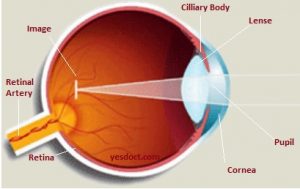Nearsightedness, Myopia
Nearsightedness, Myopia
Nearsightedness also known as myopia is characterized by inability to focus on far objects. It is a common vision problem that occur due to change in the shape of eye resulting in the refraction of light rays incorrectly and formation of image in front of retina instead of on retina.
Symptoms
- Distant objects looks blurry
- Squint or partially closing eyes in order to see clearly
- Eye strain
- Headache
- Difficulty in driving vehicle, especially at night which is known as night myopia.
- A child with nearsightedness presents as squint persistently, need to sit closer to the screen and tv, frequently rubbing of eyes, unaware of far objects.
Causes
This is a refractive error of the eye which occur due to loss of smooth curve or even surface of cornea or lens. Due to this refractive error incoming light rays focus in front of retina and form blurry image of distant objects. Cornea curve too steeply than normal when eyeball become longer.
Complications
Complications of nearsightedness are:
- Affected quality of life
- Squint or persistent eyestrain
- Impaired safety when driving or handling heavy machinery
- Increase risk of glaucoma, retinal detachment, myopic maculopathy
Diagnosis
Diagnosis of nearsightedness depends upon detailed medical history and complete general physical examination and refraction examination of the patient.
Treatment
Treatment options include the following:
- Prescription of corrective lenses like eyeglass, contact lenses.
- Refractive surgeries including Photorefractive keratectomy (PRK), Laser-assisted subepithelial keratectomy (LASEK), Laser-assisted in situ keratomileusis (LASIK).
- Topical drops like atropin also aid in nearsightedness; exact mechanism is unknown
Lifestyle and home remedies
- Keep blood pressure and diabetes under control as it can worsen the eyesight
- Wear glasses for protection of eye from sun UV rays
- Protect eye from chemical injuries
- Eat healthy and organic foods
- Be active and exercise regularly
- Wear rightly prescribed glasses.
- Quit smoking
- Read and write in good lighting.
